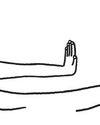
When Beatriz Flamini was growing up, in Madrid, she spent a lot of time alone in her bedroom. "I really liked being there," she says. She'd read books to her dolls and write on a chalkboard while giving them lessons in math or history.
As she got older, she told me, she sometimes imagined being a professor like Indiana Jones: the kind who slipped away from the classroom to "be who he really was." In the early nineteen-nineties, while Flamini was studying to be a sports instructor, she visited a cave for the first time. She and a friend drove north of Madrid to El Reguerillo, a cavern known for its paleolithic engravings. "We stayed until Sunday and came out only because we had classes and work," Flamini recalls. El Reguerillo was dark but cozy, and inside its walls she experienced an overwhelming sense of love. "There were no words for what I felt," she says.
After graduating, Flamini taught aerobics in Madrid. She was admired for her charisma and commitment. "Everyone wanted me for their classes," she says. "They fought over me." By the time she turned forty, in 2013, she had a partner, a car, and a house. But she felt unsatisfied. She didn't really care about financial stability, and, unlike most people she knew, she didn't want children. She experienced an existential crisis. "You know you're going to die-today, tomorrow, within fifty years," Flamini told herself. "What is it that you want to do with your life before that happens?" The immediate answer, she remembers, was to "grab my knapsack and go and live in the mountains."
Flamini moved to the Sierra de Gredos, in central Spain, where she worked as a caretaker at a mountain refuge. She became certified in safety protocols for working on tall structures, and she learned first-aid skills, specializing in retrieving people from deep crevices and other perilous locations.
This story is from the January 29, 2024 edition of The New Yorker.
Start your 7-day Magzter GOLD free trial to access thousands of curated premium stories, and 9,000+ magazines and newspapers.
Already a subscriber ? Sign In
This story is from the January 29, 2024 edition of The New Yorker.
Start your 7-day Magzter GOLD free trial to access thousands of curated premium stories, and 9,000+ magazines and newspapers.
Already a subscriber? Sign In

BADDIE ISSUES
\"Wicked\" and \"Gladiator II.\"

LET'S MAKE A DEAL
\"Death Becomes Her\" and \"Burnout Paradise.\"

ANTI HEROES
\"The Franchise,\" on HBO.

FELLOW-TRAVELLERS
The surprisingly sunny origins of the Frankfurt School.

NOW YOU SEE ME
John Singer Sargent's strange, slippery portraits of an art dealer's family.

PARIS FRIEND - SHUANG XUETAO
Xiaoguo had a terror of thirst, so he kept a glass of water on the table beside his hospital bed. As soon as it was empty, he asked me to refill it. I wanted to warn him that this was unhealthy - guzzling water all night long puts pressure on the kidneys, and pissing that much couldn't be good for his injury. He was tall, though, so I decided his insides could probably cope.

WILD SIDE
Is Lake Tahoe's bear boom getting out of hand?

GETTING A GRIP
Robots learn to use their hands.

WITHHOLDING SEX FROM MY WIFE
In the wake of [the] election, progressive women, who are outraged over Donald Trump's victory at the ballot box, have taken to social media with public, vengeful vows of chastity. - The Free Press.

DEADLINE EXTENSION
Old age, reborn.